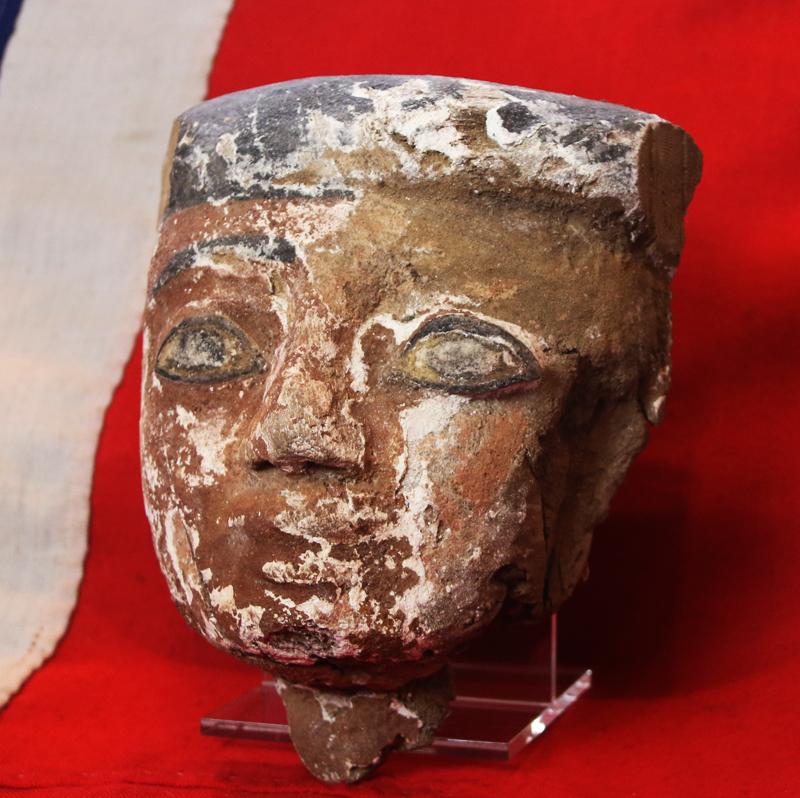
1 / 10
A Fabulous Original Egyptian Carved Wooden Mummy Mask 25th to 26th Dynasty Period to late Dynastic Period
Available
£7950.00
—
Description
Around 2700 to 2350 years old. Beautifully painted over a gesso type plaster on cedar wood, with a substantial amount of paint remaining, showing excellent flesh tones, probably bronze insert eye lines with white painted eyes and large black pupils. Piye established the Twenty-fifth Dynasty and appointed the defeated rulers as his provincial governors. He was succeeded first by his brother, Shabaka, and then by his two sons Shebitku and Taharqa. The reunited Nile valley empire of the 25th Dynasty was as large as it had been since the New Kingdom. Pharaohs of the dynasty, among them Taharqa, built or restored temples and monuments throughout the Nile valley, including at Memphis, Karnak, Kawa, and Jebel Barkal. The 25th Dynasty ended with its rulers retreating to their spiritual homeland at Napata. It was there (at El-Kurru and Nuri) that all 25th Dynasty pharaohs were buried under the first pyramids to be constructed in the Nile valley in hundreds of years A mummy mask provided protection – both physical and magical – to the head of the mummy. Masks were introduced in the First Intermediate Period (c. 2181-2955 BC) and were used until Roman times (30BC-395AD). They show the deceased in an idealised form, like a god who has triumphed over death. The use of gilding on masks of the wealthy symbolises the golden skin of the gods. Spell 151 from the Book of the Dead – the 'Spell for the Head-of-Mystery' – makes the function of the mask explicit: Anubis speaks, the embalmer, lord of the divine hall, when he has placed his hands on the coffin of [the deceased] and equipped him with what [he] needs: 'Hail, O beautiful of face, lord of vision, whom Ptah-Sokar has gathered together and whom Anubis has upraised, to whom Shu gave support, O beautiful of face among the gods! Your right eye is the night boat, your left eye is the day boat, your eyebrows are the Ennead. The crown of your head is Anubis, the back of your head is Horus, your fingers are Thoth, your lock of hair is Ptah-Sokar. You [the mask] are in front of [the deceased], he sees by means of you. [You] lead him on the goodly ways, you repel Seth's band for him and cast his enemies under his feet for him in front of the Ennead of the great House of the Noble in Heliopolis. You take the goodly way to the presence of Horus, the lord of the nobles.' This text appears on the famous golden mask of Tutankhamun, inscribing an object with its function in order to ensure that it would 'work' for the dead king. The spell makes clear that the mask was to protect the deceased (magically) from their enemies. As is common in such spells, the text is a command from a god to an inanimate object – divine authority used to spark to life a lifeless substance. The spell emphasises the power of the mask to restore to the deceased the ability to see. An important part of the funeral ritual was a rite known as the 'Opening of the Mouth', which restored the power of speech, as well as the other senses to the mummy (set up outside the tomb, probably wearing the mummy mask). The senses were required for a successful rebirth into in the afterlife as a fully-functioning person, as in life. Masks were made to give their owners the power of sight – and speech. To show how mummy masks have become so desirable and collectable we show two masks sold in Sotheby's 2011 for 15,000

